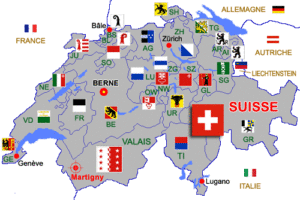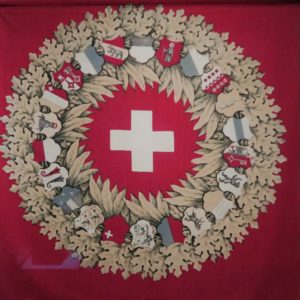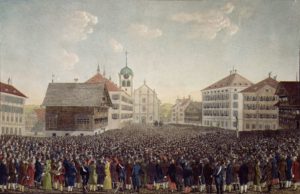Switzerland, A European Microcosmos ?
5 July 2023
Switzerland is the outcome of centuries of cooperation, alliances, exchanges and contacts between the cantons. After the Congress of Vienna (1814-1815), it seemed impossible to unite these sovereign republics and their different languages, religions, cultures and (economic) interests in a federation with a national currency, government, parliament, army or even a flag or a national anthem.
The Constitution of 1848
In 1848, after the brief civil war of 1847 (Sonderbundskrieg), the Constitution of 1848 founded the Confoederatio Helvetica (CH), the Swiss Confederation of twenty-five (semi)cantons.
The successful monetary, political, cultural and economic integration continues today. For some, it is a (democratic) inspiration of European integration, a European microcosm.
Others believe that Switzerland indicates the maximum achievable European cooperation between different countries. Or should the EU join the Swiss Confederation as the twenty-seventh canton (after the consent of the Swiss citizens and cantons, that goes without speaking)?

M. Valéry Giscard d’Estaing (2008) and President François Hollande (2016). Pregny Chambésy, Musée des Suisses dans le monde. Foto: TES
“The next membership of the European Union ….. of Switzerland’, ‘It is in Switzerland that the European dream has become a reality.”
Continuity and the political system
The story of Switzerland is, above all, the centuries of continuity and the choices for the political system. That distinguishes Switzerland from other European regions that have also cooperated in loose relationships for a long time, such as the Hanseatic League or the Swabian League.
Fate, coincidence and the course of history are not considered in this article. Things could have gone differently for Switzerland as well, ‘if’. The fact that Switzerland exists, however, is no coincidence. The first political foundations date back to the late Middle Ages, from the thirteenth to the fifteenth century. At that time, however, nothing could indicate that the Switzerland of 1848 would come into being.

The 26 cantons. Source: Les 26 cantons suisses. Foto: www.jeretiens.net
The cantons
The Eidgenossenschaft or Confederation of 1513 and its thirteen cantons (this term dates back to the sixteenth century) withstood the European (religious) wars and revolutions.
The mainly German-speaking cantons (only Fribourg/Freiburg was bilingual) emerged from the thirteenth century onwards as sovereign political regions with their jurisdictions, cultures, armies, currencies, flag, languages/dialects, legislation, parliaments, governments, foreign policies (including peace, war and treaties) and ambassadors without interference from a national authority or a (foreign) sovereign.
In 1648 (Treaty of Westphalia), the Confederation was (de facto) recognised as a sovereign nation, although the cantons did not regard the Confederation as a nation with a national identity.
However, in the perception of the great powers of the time (notably Spanish and Austrian Habsburg, Sweden, The Republic of the United Republic of Seven Provinces, France, and England), this Confederation was a sovereign entity. The cantons achieved this status due to their success on the battlefield and political, economic and foreign policies from 1315 onwards.

Vevey, Musée de la Confrérie des Vignerons, Les Cent Suisses. Photo: TES
Tagsatzung
Apart from the Tagsatzung, i.e. the States-General, no confederal institution existed. The cantons created a General Assembly (Tagsatzung) of representatives of the cantons in 1417, after the conquest of Aargau in 1415.
Its main activity was the joint administration of the conquered territories (Untertanengebiete, Aargau, among others, Thurgau (1460), Italian territories (around 1500-1512) and Waadt (1536). It was a complex mosaic of governance that would be left aside.
The thirteen cantons mostly disagreed on other policy areas. Cooperation and foreign policy became even more complicated after the Reformation and the emergence of Protestant cantons.
Apart from six minor military conflicts (the two kappelerkriege of 1529 and 1531, the Bündner Wirren of 1618-1639, the Peasants’ War of 1653 and the two Villmergerkriege of 1656 and 1712), the cantons solved their religious and economic conflicts through consultation, always looking for the feasible and acceptable.
The Confederation was not Catholic or Protestant but was an alliance of Catholic and Protestant cantons, including all (political) problems.

The Tagsatzung, a. 1500. National Museum Zurich. Photo: TES.
The French Era 1798-1813
The French occupation and its constitutional concepts (the Helvetic Republic (1798-1803) and the Confederation (1803-1813) brought about significant and lasting changes in the confederal system.
After the defeat of Napoleon, the new Confederation of 1815 consisted, as before, of sovereign cantons (twenty-five cantons, including the six semi-cantons) without effective confederal bodies. But the clock could not be turned back.

The French invasion. Photo: Nidwalder Museum.
The Constitution of 1848
The Constitution of 1848 paved the way for modern Switzerland. It combined federalism, universal suffrage for (male) citizens, a balanced system of power-sharing between the government and parliament (the Nationalrat/Conseil national and the Ständerat/Conseil d’Etats), and a prominent role for cantons and citizens. The (male) citizens and cantons had the last word by adopting the Constitution in 1848.
After the new Confederation of 1848, the cantons were the laboratory for introducing direct democracy at the national level: the referendum (1874) and the popular initiative (1891). The introduction was a political choice of citizens and cantons. They based it on the ancient model of the ‘Landsgemeinde‘, the American Constitution of 1776, the achievements of the French era (1798-1813) and the experiences in the cantons.
Direct democracy was the lubricant of the federation of such different republics and interests. The cantons and the citizens trusted the national government, and the federal government trusted the cantons and the citizens.

Bern, House of the Cantons (Haus der Kantone). Photo: TES.
Willensnation
Therefore, Switzerland is a ‘Willensnation’ with a political system that arose bottom-up for and by the citizens and their cantons. Until 1798, Switzerland had no dominant national personality or dynasty and no dominant canton (it did have (very) large and (very) small cantons). Until 1848, there was no national identity, only solidarity. However, this union was mainly pragmatic and served the interests of the cantons.

Bern, Federal Palace. Photo: TES.
Democracy
The Swiss model is not God-given predestination. It is a human process of trial and error. An essential aspect of the Swiss model is its ability to adapt to changing social, international and economic developments.
The compromise model and the national government’s so-called ‘Konkordanzsystem’ have arisen from the need to consult with all ‘stakeholders’ of the society. The federal structure of the political system, the cantons in the Ständerat and direct democracy for the citizens are the constitutional fundaments.
The national government, parliament, cantons, and all relevant organisations are involved in the legislative process in the pre-parliamentary phase. After all, the citizens and the cantons always have the last word.

Unity in Diversity, 1935. National Museum Zurich. Photo: TES
Conclusion
Switzerland’s integration is not perfect. There is a Röstigraben and a Stadt-Landgraben, there was a late (national) introduction of women’s suffrage (which does not necessarily say anything about the Swiss man) and obtaining citizenship for foreigners, including the right to vote, is not self-evident. Granting citizenship is an ancient competence of the cantons and municipalities.
The Covid-19 pandemic and the relationship with the European Union are reasons to examine the relationship between the government and cantons. However, the system is reformable only after (lengthy) discussion and consultation with cantons and citizens.
The Swiss model is unique and a political choice for the citizens and their cantons.
Switzerland is not only the undisputed world champion of referendums. Direct democracy is not an end in itself. The system is embedded in a centuries-old bottom-up model at municipal, cantonal and national levels.
It has served the country well, even in times of great crisis, for example, the civil war of 1847, the polarization of 1914-1918 and the decades leading up to the creation of the new canton of Jura in 1979.
Direct democracy does not always simplify the political life of the federal (and cantonal and municipal) executive and legislature, and it is also the subject of reform discussions in Switzerland.
However, the citizens and the cantons are proof of its success. Legislation or a popular initiative to abolish direct democracy has never been realised.
Source: W. Lindner/Sean Mueller, Schweizerische Demokratie. Institutionen, Prozesse, Perspektiven, fourth edition, Bern 2017; A. Vatter, Das politische System der Schweiz, Baden-Baden, 2020; O. Meuwly, Une histoire de la démocratie direct en Suisse, Neuchâtel, 2020)

